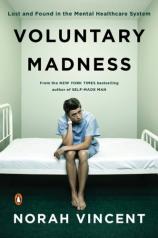Voluntary Madness: My Year Lost and Found in the Loony Bin
Review
Voluntary Madness: My Year Lost and Found in the Loony Bin
Norah Vincent is the author of the bestseller SELF-MADE MAN. Her
writing has appeared in publications such as The Los Angeles
Times and The Village Voice. Recently, she was
institutionalized in a psychiatric hospital that mainly serves the
poor or indigent mentally ill and drug-addicted population of New
York City. This, she tells readers in her latest book, VOLUNTARY
MADNESS --- a blend of journalistic exposé and memoir --- was
for research. But, she also admits, it was for treatment as
well.
What makes VOLUNTARY MADNESS so interesting, and at times
frustrating, is the gray area between her two explicit goals: to
write objectively about the state of mental health hospitals and to
record her experiences as a patient who is occasionally in
legitimate need of the services such hospitals provide.
Over the course of a year Vincent stayed in three very different
hospitals, for a total of about a month. She was inspired to do so
after she checked herself into what she calls “the bin”
while writing her last book. She had suffered from depression
previously, and the intensity of the work she was doing triggered
another depressive episode. It was during this time in the hospital
that she hit upon the idea of checking herself into a variety of
hospital settings for a book. She selected three, in different
locales and with different therapeutic approaches, and presented
herself with the same set of issues (the ones she actually deals
with), though she didn't tell the hospital administrators,
caregivers or her fellow patients that in reality she was doing
research for a book.
Her first stay was at the aforementioned urban hospital. The
care consisted, for the most part, of high doses of medication and
a safe place to crash. The caregivers were, in Vincent's opinion,
impersonal and distant, and the therapy was essentially
non-existent. Her second stay was much different; she checked
herself into a small, semi-rural Catholic hospital that was
comfortable and homey, with a caring staff and a trusting and kind
physician at the helm. Despite the differences, the two
institutions were afflicted with many of the same problems,
including a revolving door of patients who, once stabilized, are
released only to return again presenting the same symptoms.
The third hospital, too, dealt with the same issues. This
private facility offered a variety of progressive and traditional
therapies and allowed patients to live in private apartments. It
promoted exercise and good nutrition. Still, the majority of the
patients had been institutionalized several times for either mental
health issues or addiction (which, Vincent convincingly suggests,
are often two sides of the same coin). Many were there because of
court orders, just as in the first hospital. While it was in this
third and final place that Vincent had a major therapeutic
breakthrough of her own, which she shares with raw honesty, she
finds that in the end it was not as different of a place from the
other two. The reason, she suggests, has to do not with the quality
of care or the mission or goals of a particular hospital or clinic
but American cultural ideas about mental illness and addiction.
Drug companies and doctors who over-prescribed come under much fire
here as contributing to this epidemic problem.
Her thesis seems to slightly shift a few times in the book. And
the back and forth movement from objective journalist to patient is
less than graceful throughout. The book itself has some interesting
ethical dilemmas (going undercover in a mental health facility and
playing with prescribed drugs to get a certain outcome, for
example). Whether one agrees with all of her ideas or even her
methods, VOLUNTARY MADNESS is sure to raise many good questions and
become fodder for debate.
Reviewed by Sarah Rachel Egelman on January 24, 2011
Voluntary Madness: My Year Lost and Found in the Loony Bin
- Publication Date: December 29, 2009
- Genres: Nonfiction
- Paperback: 304 pages
- Publisher: Penguin (Non-Classics)
- ISBN-10: 0143116851
- ISBN-13: 9780143116851





